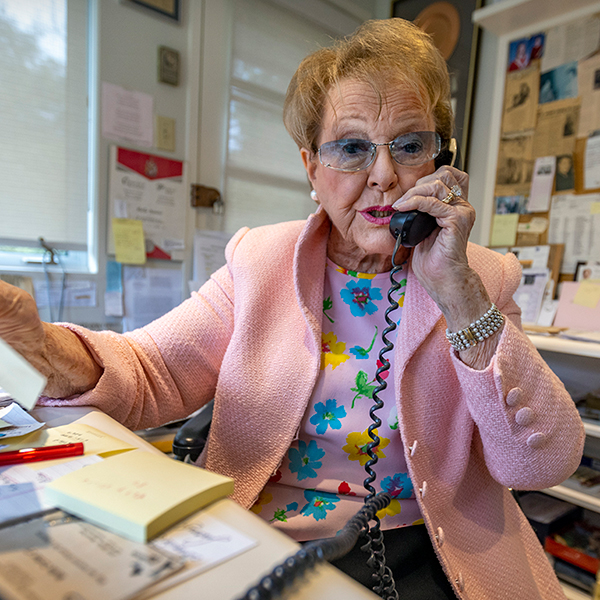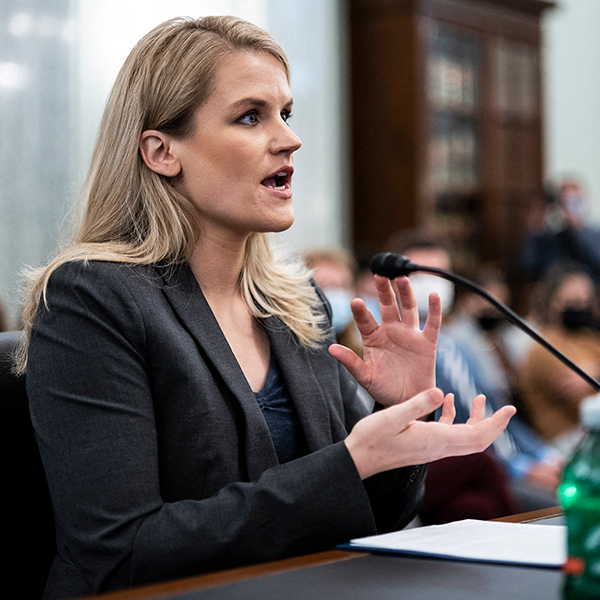If Blanche Lemco van Ginkel, BArch’45, DSc’14, had never lived in Montreal, the city would look very different than it does today – and not in a good way.
The southern slope of Mount Royal would probably be overcrowded with apartment towers. Expo 67 might never have happened. And a huge chunk of Old Montreal, the city’s most iconic and historic neighbourhood, would have been gutted to make room for an expressway.
And that just covers some of the things that she and her husband Sandy van Ginkel were up to in the late fifties and early sixties – a small portion of her long and remarkable career.
The Royal Architectural Institute of Canada (RAIC) recently awarded Lemco van Ginkel its Gold Medal. It’s the top prize for career achievement in Canadian architecture and past recipients include Douglas Cardinal, DSc’17, Arthur Erickson, BArch’50, LLD’75, Frank Gehry, Phyllis Lambert, DLitt’86, Raymond Moriyama, MArch’57, DSc’93, and Moshe Safdie, BArch’61, LLD’82.
“She helped pave the way”
Architectural historian Annmarie Adams, BA’81, McGill’s Stevenson Chair in the History and Philosophy of Science, has written frequently about Lemco van Ginkel’s work over the years, notably in the book Designing Women. “She is just such a rock star in architecture,” says Adams. “This [recognition] is fantastic.”
In 1940, Lemco van Ginkel became one of the first women to attend McGill’s School of Architecture (the school only began accepting female applicants the year before). “She has been such a trailblazer,” says Adams. “The phrase ‘one of the first’ comes up a lot with her.”
Lemco van Ginkel was one of the first women to teach at the University of Pennsylvania, one of the first women to become a member of Quebec’s professional association for architects, the first woman to become a Fellow of the RAIC, the first woman to serve as dean of a school of architecture in North America (at the University of Toronto), the first woman (and first Canadian) to become the president of the Association of Collegiate Schools of Architecture.
“At one point in the 2010s, there were a number of women who were the heads of architecture schools in Canada, including me [at McGill],” says Adams. “And when we got together, Blanche’s name came up often. We knew she helped pave the way for us.”
Collaborating with Le Corbusier
In 1948, as a young architect, Lemco van Ginkel landed a position in the studio of one of the 20th century’s most influential architects, France’s Le Corbusier. She worked on one of the French master’s most famous projects, the Unité d’habitation in Marseille, playing a key role in creating the building’s acclaimed rooftop terrace.
“It is one of the really exquisite accomplishments of the postwar period and really a magnificent space – and also a very human space,” says Mary McLeod, a professor of architecture at Columbia University. “It [had] a functioning nursery school up there and it was just a wonderful place to be in. [Lemco van Ginkel] played a major role in its design under the guidance of Le Corbusier.”
Lemco van Ginkel recently recalled what it was like to work with Le Corbusier.
“I was surprised that I was never told what to do,” she says. “It felt like being a student again: He would set a challenge and if I came up with an idea he liked, he would ask me to develop it – and if he didn’t like it, he would throw it out! It was extraordinary how much freedom we had.”
Her longest and most productive professional relationship, though, was with her husband Sandy. The couple created van Ginkel Associates, and took on a wide assortment of projects – the design of the award-winning Bowering Park in Newfoundland, a major study of urban circulation in Manhattan, the first atlas of the communities of the Mackenzie River in the Northwest Territories.
“We complemented each other in knowledge and skills,” says Lemco van Ginklel. “We were a good partnership, living and breathing our work together.” Sandy died in 2009.
Making their mark on Montreal
The van Ginkels probably had their biggest impact in Montreal, the city in which they launched their firm in the late fifties.
Inderbir Riar, an associate professor at Carleton University’s Azrieli School of Architecture & Urbanism, has written about the van Ginkels’ time in Montreal and their involvement in Expo 67.
“They were bringing the sensibility and intellectual ethos of the European avant-garde to Montreal,” says Riar. “They had this very strong post-war humanist credo. The other thing they were bringing, specifically Blanche, was a new way of thinking about urban design that was coming out of the east coast American universities where she had studied and taught – Harvard and the University of Pennsylvania. She was part of a handful of people [who had been] recruited to essentially build urban design as a discipline at the University of Pennsylvania – almost from scratch.”
When serious plans emerged to create a highway through Old Montreal, the van Ginkels moved quickly to oppose it. In an interview with The Montreal Gazette in 2012, Lemco van Ginkel explained that Old Montreal’s unique historical role wasn’t much prized by city officials at the time. “It was [regarded as] just the shabby older section of the city.”
The van Ginkels prepared a report for Montreal port authorities that warned that a highway through Old Montreal would seriously disrupt port operations. In an interview with author John Lownsbrough, Lemco van Ginkel said the report, which created a furor in the media once it was leaked, had a bigger purpose in mind from the start. “What it was, was [a plan] to save Old Montreal.”
In follow-up reports, some commissioned by Montreal’s planning department, the van Ginkels kept making their case for Old Montreal’s importance and distinct nature. In 1964, the province declared it a historic district. Dinu Bumbaru, the policy director for Heritage Montreal, credits the van Ginkels and city planners like Guy Legault with changing the way in which Montrealers regarded their architectural history.
“It was not a nostalgic impulse on their part,” says Bumbaru. “The van Ginkels were modernists. They believed in modern architecture. But they didn’t disconnect that from caring about heritage. Not heritage in the sense of we’ll keep an historic building here and another one there, but a deeper sense of the role that heritage plays in our urban fabric. Today we take that [sort of thinking] for granted, but there was a time when it didn’t exist.”
The van Ginkels played a similar role with Mount Royal, opposing developments projects and arguing for the expansion of Mount Royal Park. The efforts they led prompted governments to enact protective legislation.
“It’s one thing to be a lone hero, but to have an impact, you have to be able to create a movement,” says Bumbaru. “They managed to rally forces in society [for these causes].”
Riar says the van Ginkels had built up strong connections with Montrealers of influence on both the English and French sides – architects, civic leaders, business leaders. “There is a kind of noblesse oblige in a lot of these circles and the van Ginkels [were] in a way the movers and shakers.”
The early days of Expo
Those connections would prove to be crucial for another ambitious project. “The van Ginkels were at the centre of planning the nascent stages of what would become Expo 67,” says Riar. “There [was] this group of plutocratic business and civic interests that reaches out to them and this group, led by the van Ginkels, basically comes up with the idea of a Montreal World’s Fair.”
When Montreal mayor Jean Drapeau made his successful bid to host a world’s fair in Montreal, the proposal he presented had been devised by the van Ginkels. Soon after, Sandy was officially hired to oversee the master plan for Expo.
The van Ginkels were no longer formally involved with Expo when it opened in 1967 (there were tensions around budgets and other issues and Sandy moved on in 1963), but the hugely successful event still reflected their vision in large part.
“There is no question that [the van Ginkels] delivered the master plan,” says Riar. “The overall theme of Man and His World, the themed pavilions like Man the Producer, Man the Explorer – that really came out of their humanist approach.” One of the talented young architects recruited to be part of Sandy’s Expo team was Moshe Safdie. Safdie had a condition before agreeing to the job – he wanted to turn his McGill thesis project (Sandy had served as his advisor) into reality. That became Habitat, perhaps Montreal’s best known work of architecture internationally. Some of Expo’s pavilions have been transformed into enduring parts of the city’s landscape – the Montreal Casino and the Montreal Biosphere, for instance.
While Bumbaru is delighted to see Lemco van Ginkel receive her due, he believes the City of Montreal should create some form of lasting tribute to commemorate the contributions that she and Sandy made to the city. “They are known [in professional circles], but not to the public. They deserve to be remembered.”


